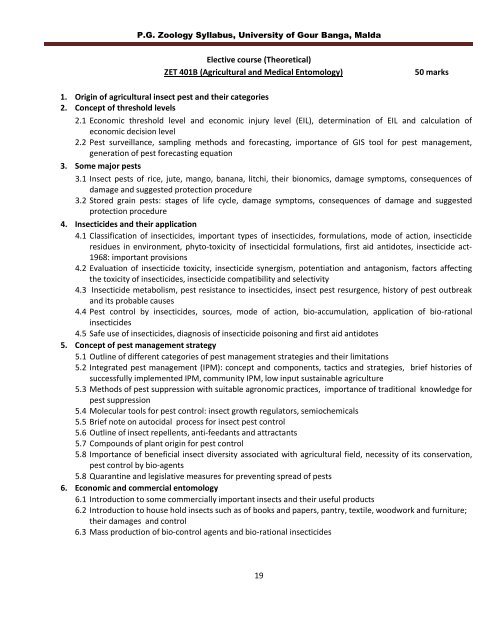Zoology - University of Gour Banga
Zoology - University of Gour Banga
Zoology - University of Gour Banga
Create successful ePaper yourself
Turn your PDF publications into a flip-book with our unique Google optimized e-Paper software.
P.G. <strong>Zoology</strong> Syllabus, <strong>University</strong> <strong>of</strong> <strong>Gour</strong> <strong>Banga</strong>, MaldaElective course (Theoretical)ZET 401B (Agricultural and Medical Entomology)50 marks1. Origin <strong>of</strong> agricultural insect pest and their categories2. Concept <strong>of</strong> threshold levels2.1 Economic threshold level and economic injury level (EIL), determination <strong>of</strong> EIL and calculation <strong>of</strong>economic decision level2.2 Pest surveillance, sampling methods and forecasting, importance <strong>of</strong> GIS tool for pest management,generation <strong>of</strong> pest forecasting equation3. Some major pests3.1 Insect pests <strong>of</strong> rice, jute, mango, banana, litchi, their bionomics, damage symptoms, consequences <strong>of</strong>damage and suggested protection procedure3.2 Stored grain pests: stages <strong>of</strong> life cycle, damage symptoms, consequences <strong>of</strong> damage and suggestedprotection procedure4. Insecticides and their application4.1 Classification <strong>of</strong> insecticides, important types <strong>of</strong> insecticides, formulations, mode <strong>of</strong> action, insecticideresidues in environment, phyto-toxicity <strong>of</strong> insecticidal formulations, first aid antidotes, insecticide act-1968: important provisions4.2 Evaluation <strong>of</strong> insecticide toxicity, insecticide synergism, potentiation and antagonism, factors affectingthe toxicity <strong>of</strong> insecticides, insecticide compatibility and selectivity4.3 Insecticide metabolism, pest resistance to insecticides, insect pest resurgence, history <strong>of</strong> pest outbreakand its probable causes4.4 Pest control by insecticides, sources, mode <strong>of</strong> action, bio-accumulation, application <strong>of</strong> bio-rationalinsecticides4.5 Safe use <strong>of</strong> insecticides, diagnosis <strong>of</strong> insecticide poisoning and first aid antidotes5. Concept <strong>of</strong> pest management strategy5.1 Outline <strong>of</strong> different categories <strong>of</strong> pest management strategies and their limitations5.2 Integrated pest management (IPM): concept and components, tactics and strategies, brief histories <strong>of</strong>successfully implemented IPM, community IPM, low input sustainable agriculture5.3 Methods <strong>of</strong> pest suppression with suitable agronomic practices, importance <strong>of</strong> traditional knowledge forpest suppression5.4 Molecular tools for pest control: insect growth regulators, semiochemicals5.5 Brief note on autocidal process for insect pest control5.6 Outline <strong>of</strong> insect repellents, anti-feedants and attractants5.7 Compounds <strong>of</strong> plant origin for pest control5.8 Importance <strong>of</strong> beneficial insect diversity associated with agricultural field, necessity <strong>of</strong> its conservation,pest control by bio-agents5.8 Quarantine and legislative measures for preventing spread <strong>of</strong> pests6. Economic and commercial entomology6.1 Introduction to some commercially important insects and their useful products6.2 Introduction to house hold insects such as <strong>of</strong> books and papers, pantry, textile, woodwork and furniture;their damages and control6.3 Mass production <strong>of</strong> bio-control agents and bio-rational insecticides19


